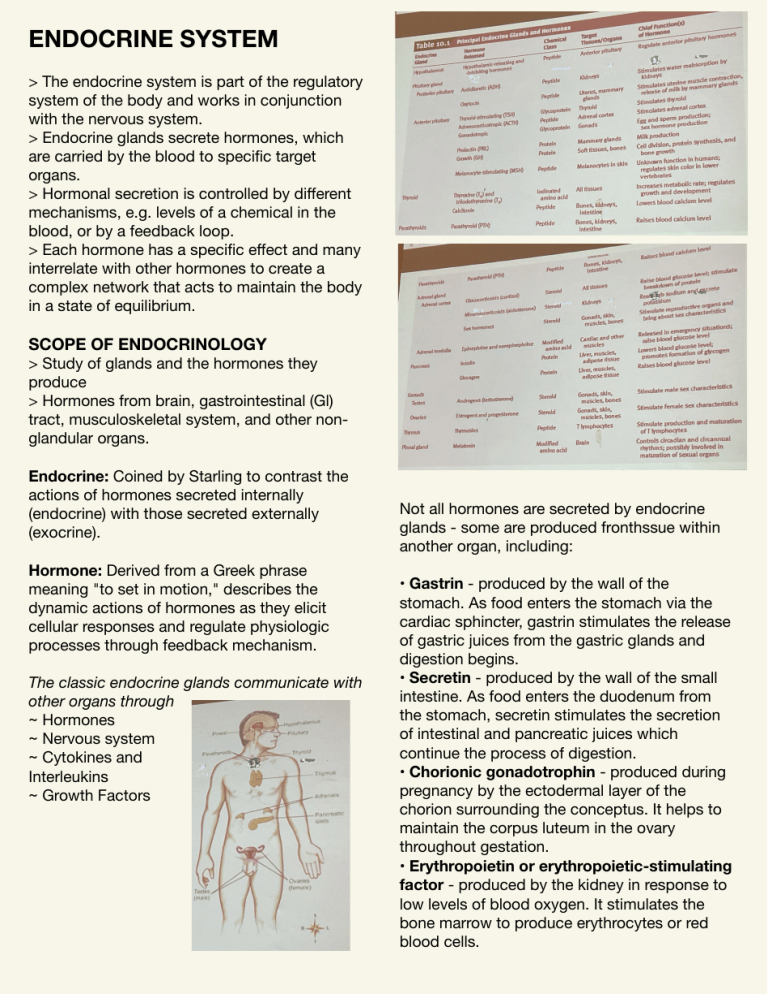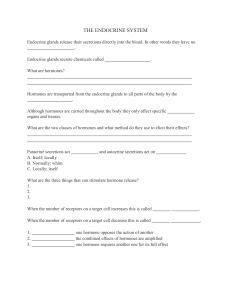Endocrine System Overview: Hormones, Glands, and Diseases
advertisement

ENDOCRINE SYSTEM > The endocrine system is part of the regulatory system of the body and works in conjunction with the nervous system. > Endocrine glands secrete hormones, which are carried by the blood to specific target organs. > Hormonal secretion is controlled by different mechanisms, e.g. levels of a chemical in the blood, or by a feedback loop. > Each hormone has a specific effect and many interrelate with other hormones to create a complex network that acts to maintain the body in a state of equilibrium. SCOPE OF ENDOCRINOLOGY > Study of glands and the hormones they produce > Hormones from brain, gastrointestinal (Gl) tract, musculoskeletal system, and other nonglandular organs. Endocrine: Coined by Starling to contrast the actions of hormones secreted internally (endocrine) with those secreted externally (exocrine). Hormone: Derived from a Greek phrase meaning "to set in motion," describes the dynamic actions of hormones as they elicit cellular responses and regulate physiologic processes through feedback mechanism. The classic endocrine glands communicate with other organs through ~ Hormones ~ Nervous system ~ Cytokines and Interleukins ~ Growth Factors Not all hormones are secreted by endocrine glands - some are produced fronthssue within another organ, including: • Gastrin - produced by the wall of the stomach. As food enters the stomach via the cardiac sphincter, gastrin stimulates the release of gastric juices from the gastric glands and digestion begins. • Secretin - produced by the wall of the small intestine. As food enters the duodenum from the stomach, secretin stimulates the secretion of intestinal and pancreatic juices which continue the process of digestion. • Chorionic gonadotrophin - produced during pregnancy by the ectodermal layer of the chorion surrounding the conceptus. It helps to maintain the corpus luteum in the ovary throughout gestation. • Erythropoietin or erythropoietic-stimulating factor - produced by the kidney in response to low levels of blood oxygen. It stimulates the bone marrow to produce erythrocytes or red blood cells. Endocrine diseases three major types of conditions: (1) Hormone excess Syndromes of hormone excess can be caused by ~ Neoplastic growth of endocrine cells ~ Autoimmune disorders ~ Excess hormone administration ~ Benign endocrine tumors, including parathyroid, pituitary, and adrenal adenomas (2) Hormone deficiency Glandular destruction caused by: ~ Autoimmunity ~ Surgery ~ Infection ~ Inflammation ~ Infarction ~ Hemorrhage ~ Tumor infiltration Autoimmune damage to the thyroid gland (Hashimoto's thyroiditis) and pancreatic islet B cells (type I diabetes mellitus) are examples of relatively common endocrine diseases. (3) Hormone resistance Most severe hormone resistance syndromes are due to inherited defects in membrane receptors, nuclear receptors, or the pathways that transduce receptor signals. These disorders are characterized by defective hormone action despite the presence of increased hormone levels. In complete androgen resistance, for example, mutations in the androgen receptor result in a female phenotypic appearance in genetic (XY) males, even though LH and testosterone levels are increased CLINICAL EVALUATION OF ENDOCRINE DISORDERS Physical examination focuses on the manifestations of hormone excess or deficiency as well as direct examination of palpable glands, such as the thyroid and gonads. Evaluate patients in the context of their presenting symptoms, review of systems, family and social history, and exposure to medications that may affect the endocrine system. Ex: A patient with Cushing's syndrome manifest specific findings, such as central fat redistribution, skin striae, and proximal muscle weakness, in addition to features seen commonly in the general population, such as obesity, plethora, hypertension, and glucose intolerance. Hypothyroidism - with mental slowing, fatigue, dry skin. HORMONE MEASUREMENTS AND ENDOCRINE TESTING Immunoassays are the most important diagnostic tool in endocrinology, as they allow sensitive, specific, and quantitative determination of steady-state and dynamic changes in hormone concentrations. Immunoassays use antibodies to detect specific hormones. The value of quantitative hormone measurements lies in their correct interpretation in a clinical context. The normal range for most hormones is relatively broad, often varying by a factor of two- to tenfold. The normal ranges for many hormones are sex- and age-specific. The pulsatile nature of hormones and factors that can affect their secretion > Sleep > Meals > Medications • Cortisol values increase fivefold between midnight and dawn; • Reproductive hormone levels vary dramatically during the female menstrual cycle. Suppression tests are used in the setting of suspected endocrine hyperfunction. An example is the dexamethasone suppression test used to evaluate Cushing's syndrome. Stimulation tests generally are used to assess endocrine hypofunction. The ACTH stimulation lest, for example, is used to assess the adrenal gland response in patients with suspected adrenal insufficiency.





